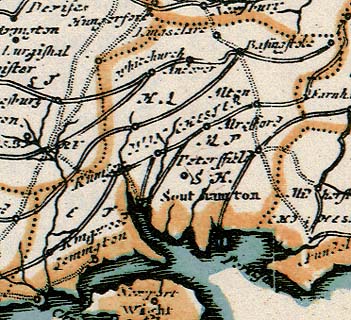
Roads, Scrolls, Distances
Ogilby's Hampshire 1675


2. The Road itself is express'd by double Black Lines if included by Hedges, or Prick'd Lines if open; but if the Road be describ'd altogether by Black Lines or Prick'd Lines throughout the whole Plate, then the Distinction aforesaid of Enclos'd and Open is omitted.


4. The several Deviations or Turnings out of the Road to adjacent Places on either Hand, are exprest by a short double Line, and are generally inscrib'd, to such a Place, and sometimes the reputed Distance of the said Place in Miles is likelwise signify'd by Figures affixt.


Each route is a long narrow map of a road. The route is arranged so that the user travels 'up the page' and is sectioned into strips, each drawn on a 'scroll' which has its ends curled decoratively. The engraver has shaded the scroll to make it look real - which sometimes obscures map detail a little.
There might be 4, 5, 6 or 7 scrolls on a plate. Wider scrolls are used when the bendiness of the road demands more space. On some plates the continuation from scroll to scroll is demonstrated by letters, a D at the top of one scroll belonging to the D at the bottom of the next; this device might continue onto the next plate. (Note that it is clearly not right to refer to scroll D, etc.) Where we have needed to distinguish one scroll from another, in indexing, scrolls have been numbered 1, 2, ... from the left of each plate.
In the Delineation or Decyphering these Roads upon Copper-Sculptures:
1. We have Projected them upon imaginary Scrolls, the Initial City or Town being always at the Bottom of the outmost Scroll on the Left Hand; whence your Road ascends to the Top of the said Scroll; then from the Bottom of the next Scroll ascends again, thus constantly ascending till it terminate at the Top of the outmost Scroll on the Right Hand, as by the Succession of Figures representing the Miles, mostly plainly appears.

... the beginning of Computation from the Standard in Cornhill ... the said Miles being exprest by double Points, and numbred by the Figures 1, 2, 3, &c. Each subdivided into 8 Furlongs, represented by the single Points included between the said double Ones.The measurements seem to be very accurate; but things occasionally slip. The double and single points might be muddled or misplaced; the numbering wrongly engraved; etc. In the version of plate 53 in the HMCMS collection the distances on the map disagree with the distances quoted in the text source. The version of plate 97 has erasures and corrections.
It is possible to match Ogilby's roads to today's with surprising accuracy - where the road still exists.
turnings
pl.30 scroll 4 mile 44'5 1:m: to Hasilmore
pl.30 scroll 5 mile 55'2, Petersfield to Chichester: 10m
pl.32 scroll 1 mile 69'6, Monxton to Winchester 12.m.
pl.51 scroll 6 mile 8'3, Romsey to Andover 12 mile
pl.81 scroll 3 mile 31'3 to Reding 12m.
pl.81 scroll 3 mile 33'6, Kingsclere to Reding 10m.
pl.81 scroll 3 mile 33'4, Kingsclere to Andover 14m
pl.81 scroll 4 mile 39'2 to Reding 10.m.
pl.81 scroll 4 mile 41'5 to Reding 10.m.
When compared to modern distances these all appear to be customary miles, not the statute miles that Ogilby uses for his survey. Ogilby himself remarks in his introduction that he gives:-
... sometimes the reputed Distance of the said Place in Miles ...
miles
... may easily observe the Erroneous and Irregular Consequencesfollowing dependence on these reputed, old, distances. His measured distances are much better.
Assuming that the computed distances are road distances we might calculate an estimate of the customary mile. But, the assumptions in doing this are cosiderable; is it the same route, is the vulgar computation a centre to centre distance, etc, - which Ogilby comments upon.
planner

Ogilby provides a map of the whole of England and Wales, shewing all the roads, at the beginning of his atlas. This is the part for Hampshire.


